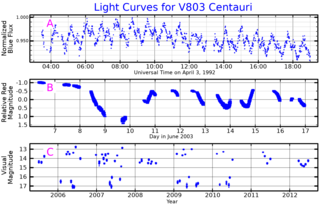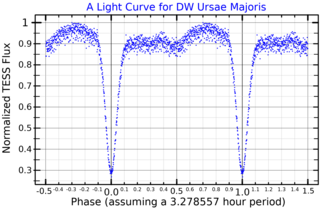
Lyra is a small constellation. It is one of the 48 listed by the 2nd century astronomer Ptolemy, and is one of the modern 88 constellations recognized by the International Astronomical Union. Lyra was often represented on star maps as a vulture or an eagle carrying a lyre, and hence is sometimes referred to as Vultur Cadens or Aquila Cadens, respectively. Beginning at the north, Lyra is bordered by Draco, Hercules, Vulpecula, and Cygnus. Lyra is nearly overhead in temperate northern latitudes shortly after midnight at the start of summer. From the equator to about the 40th parallel south it is visible low in the northern sky during the same months.

The Draco Dwarf is a spheroidal galaxy which was discovered by Albert George Wilson of Lowell Observatory in 1954 on photographic plates of the National Geographic Society's Palomar Observatory Sky Survey (POSS). It is part of the Local Group and a satellite galaxy of the Milky Way galaxy. The Draco Dwarf is situated in the direction of the Draco Constellation at 34.6° above the galactic plane.

BT Monocerotis was a nova, which lit up in the constellation Monoceros in 1939. It was discovered on a spectral plate by Fred L. Whipple on December 23, 1939. BT Monocerotis is believed to have reached mag 4.5, which would have made it visible to the naked eye, but that value is an extrapolation; the nova was not observed at peak brightness Its brightness decreased after the outbreak by 3 magnitudes in 182 days, making it a "slow nova". The light curve for the eruption had a long plateau period.

V604 Aquilae or Nova Aquilae 1905 is a nova which was first observed in the constellation Aquila in 1905 with a maximum brightness of magnitude 7.6. It was never bright enough to be seen with the naked eye. It was discovered by Williamina Fleming on a Harvard College Observatory photographic plate taken on August 31, 1905. Examination of plates taken earlier indicates that peak brightness occurred in mid-August 1905. The star's quiescent visual band brightness is 19.6.

V533 Herculis was a nova visible to the naked eye, which occurred in 1963 in the constellation of Hercules.

V373 Scuti was a nova which appeared in 1975 in the southern constellation of Scutum. It was announced on June 15, 1975 by Paul Wild at the Zimmerwald Observatory, Switzerland. At the time the magnitude was about 7.9. The peak magnitude of 7.1 occurred a month earlier on May 11.

Delta2 Lyrae is a 4th magnitude star in the constellation Lyra, approximately 900 light years away from Earth. It is one of the M4II spectral standard stars, meaning it is a bright giant star with a surface temperature around 3,600 kelvins. It puts out more energy than 10,000 suns, although more than 90% of it at longer than visual wavelengths. Direct angular measurements, combined with the Hipparcos parallax, give a radius of 1.1 - 1.3 astronomical units, comparable to the size calculated from other observed data.

RR Lyrae is a variable star in the Lyra constellation, figuring in its west near to Cygnus. As the brightest star in its class, it became the eponym for the RR Lyrae variable class of stars and it has been extensively studied by astronomers. RR Lyrae variables serve as important standard candles that are used to measure astronomical distances. The period of pulsation of an RR Lyrae variable depends on its mass, luminosity and temperature, while the difference between the measured luminosity and the actual luminosity allows its distance to be determined via the inverse-square law. Hence, understanding the period-luminosity relation for a local set of such stars allows the distance of more distant stars of this type to be determined.

V803 Centauri is a cataclysmic binary consisting of a dwarf helium star losing mass to a white dwarf. It is an example of the AM Canum Venaticorum type of cataclysmic variable stars.

SX Leonis Minoris is a dwarf nova of the SU Ursae Majoris type that was first discovered as a 16th magnitude blue star in 1957, before its identity was confirmed as a dwarf nova in 1994. The system consists of a white dwarf and a donor star which orbit around a common centre of gravity every 97 minutes. The white dwarf sucks matter from the other star via its Roche lobe onto an accretion disc which is heated to between 6000 and 10000 K and periodically erupts every 34 to 64 days, reaching magnitude 13.4 in these outbursts and remaining at magnitude 16.8 when quiet. These outbursts can be split into frequent eruptions and less frequent supereruptions. The former are smooth, while the latter exhibit short "superhumps" of heightened activity and last 2.6% longer.

CE Gruis is a faint binary star system in the constellation Grus. It is a variable star, with a B-band brightness that ranges from a peak magnitude of 17.4 down to a minimum of 19.5 over a period of 108.6 minutes. The system is composed of a white dwarf and donor star, locked into a close, synchronous orbit. In such systems, known as polars, material from the donor star does not form an accretion disc around the white dwarf because of its intense magnetic field, but rather streams directly onto it along columns.

QS Telescopii is a faint, well-studied binary star system in the southern constellation Telescopium. It is composed of a white dwarf and main sequence donor star, locked into a close, circular orbit facing one another. Known as polars, material from the donor star does not form an accretion disk around the white dwarf, but rather streams directly onto it. This is due to the presence of the white dwarf's strong magnetic field. The pair undergo frequent shifts between a high and low accretion states, and it shifts between single and double accretion poles. The main pole is partially self-eclipsing.

TV Corvi, also known as Tombaugh's Star, is a dwarf nova of the SU Ursae Majoris type in the constellation Corvus that was first discovered by accident as a mysterious 12th magnitude star on a plate by Clyde Tombaugh while looking for remote planets on May 25, 1932, before its identity was confirmed as a dwarf nova by David Levy in 1990.

SU Ursae Majoris, or SU UMa, is a close binary star in the northern circumpolar constellation of Ursa Major. It is a periodic cataclysmic variable that varies in magnitude from a peak of 10.8 down to a base of 14.96. The distance to this system, as determined from its annual parallax shift of 4.53 mas, is 719 light-years. It is moving further from the Earth with a heliocentric radial velocity of +27 km/s.

UX Ursae Majoris is an Algol type binary star system in the northern circumpolar constellation of Ursa Major. It is classified as a nova-like variable star similar to DQ Herculis, although no eruptions have been reported. Since its discovery in 1933, this system has been the subject of numerous studies attempting to determine its properties. The combined apparent visual magnitude of UX UMa ranges from 12.57 down to 14.15. The system is located at a distance of approximately 952 light years from the Sun based on parallax, and is drifting further away with a radial velocity of 112 km/s.

BZ Ursae Majoris is a dwarf nova star system in the northern circumpolar constellation of Ursa Major. It consists of a white dwarf primary in a close orbit with a red dwarf. The latter star is donating mass, which is accumulating in an accretion disk orbiting the white dwarf. The system is located at a distance of approximately 505 light years from the Sun based on parallax measurements.

RZ Leonis Minoris is a cataclysmic variable star system in the northern constellation of Leo Minor. It undergoes frequent outbursts that vary in brightness from an apparent visual magnitude of 14.4 down to 16.8. Based on parallax measurements, this system is located at a distance of approximately 2,160 light years from the Sun.

SW Ursae Majoris is a cataclysmic binary star system in the northern circumpolar constellation of Ursa Major, abbreviated SW UMa. During quiescence it has an apparent visual magnitude of 16.5–17, which is too faint to be visible to the naked eye. Based on parallax measurements, it is located at a distance of approximately 526 light years from the Sun.

DW Ursae Majoris is an eclipsing binary star system in the northern circumpolar constellation of Ursa Major, abbreviated DW UMa. It is a cataclysmic variable of the SX Sextanis type, consisting of a compact white dwarf that is accreting matter from an orbiting companion star. The brightness of this source ranges from an apparent visual magnitude of 13.6 down to magnitude 18, which is too faint to be viewed with the naked eye. The distance to this system is approximately 1,920 light years based on parallax measurements.

ER Ursae Majoris is a variable star in the northern circumpolar constellation of Ursa Major, abbreviated ER UMa. It is a prototype system for a subclass of SU Ursae Majoris dwarf novae. The system ranges in brightness from a peak apparent visual magnitude of 12.4 down to 15.2, which is too faint to be visible to the naked eye. The distance to this system, based on parallax measurements, is approximately 1,163 light years.




















